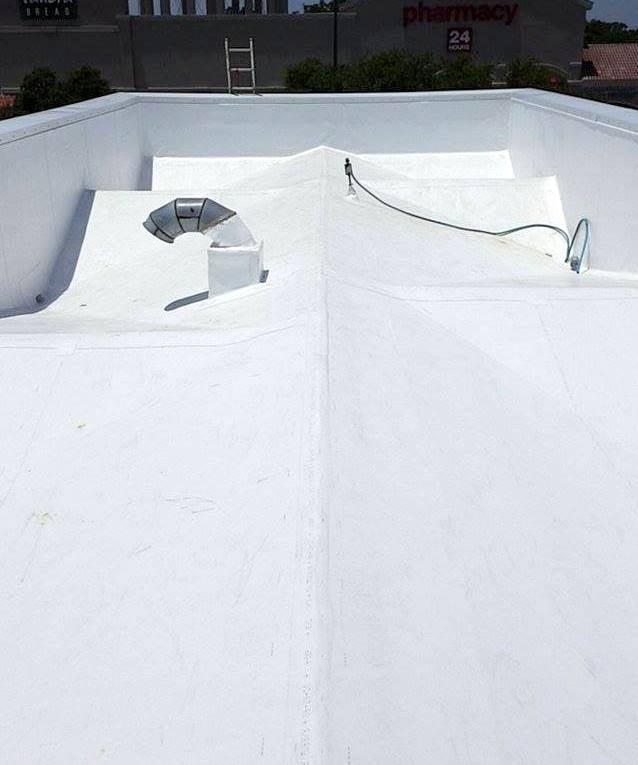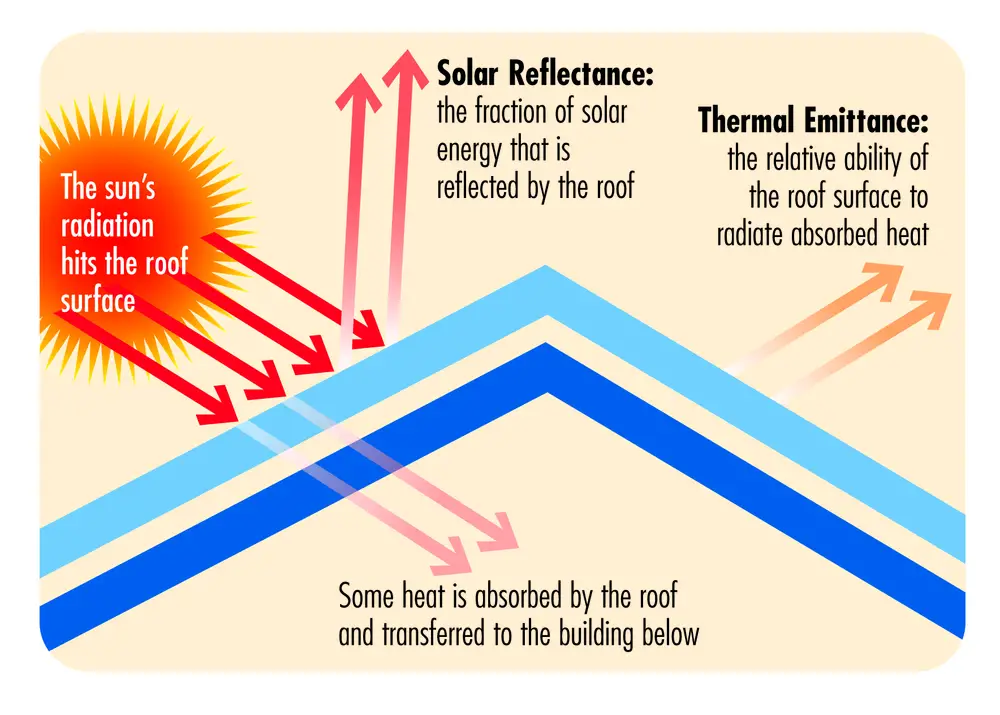Cool Roofs (Reflective Roofing): Useful Information Guide
By Jack Gray, Roof Online Editor • Updated February 24, 2023

Introduction to Cool Roofs
A “cool roof” is any roofing system constructed with roofing materials that are designed to reduce the amount of solar radiation that is transferred to the interior of a building when compared to a more traditional roof. The ability of a roof to reflect solar energy is known as its solar reflectance, while its ability to radiate absorbed heat is known as its thermal emittance.
Cool roofs are “cool” because they reflect more sunlight (they have higher solar reflectance) and they more easily release absorbed heat (they have higher thermal emittance) than a standard roof. Both of these properties contribute to a cool roof’s ability to to keep the building cooler and reduce the overall amount of energy needed for cooling.
According to our reading of the 2021 International Energy Conservation Code (the IECC), a low-slope roof can be considered a cool roof, in general, if it has a minimum three-year-aged solar reflectance of 0.55 and 3-year aged thermal emittance of 0.75. What actually qualifies as a cool roof will vary by jurisdiction. You can see the relevant code sections here.
Cool roofs are typically made of materials that are highly reflective, such as white or light-colored coatings, tiles, shingles, or membranes. Vegetative roof systems (green roofs) can also qualify as cool roofing.
In addition to reducing energy costs, cool roofs can also help mitigate the urban heat island effect, which occurs when urban areas become significantly hotter than surrounding rural areas due to the presence of heat-absorbing materials such as asphalt and concrete.
Cool roofs are suitable for a wide range of building types, including residential, commercial, and industrial buildings. They can be installed on new buildings or retrofitted onto existing roofs. Cool roof coatings may be applied to turn an existing roof into a cool roof.

Code Requirements for Cool Roofs
The use of cool roofing has been incentivized for years, chiefly through the LEED program, which any commercial property manager will have heard of.
But as state and municipal governments have adopted the more recent versions of the IECC, official code requirements for cool roofing now exist in many jurisdictions.
These requirements are intended to enforce, rather than merely incentivize, the use of energy-efficient building materials. Yes, you might have to install a cool roof.
The IECC currently includes provisions for cool roofing in certain climate zones. The 2021 version of the IECC requires new commercial buildings with low-slope roofs in climate zones 1 – 3 to meet specific cool roofing requirements, such as a minimum solar reflectance and thermal emittance. The specific requirements do vary depending on the climate zone.
In addition, the 2021 version of the IECC has updated the climate zone map for the first time since 2003. Approximately 10% of all US counties have now changed climate zones, almost all of them shifting to a lower (warmer) zone. One significant local change was the shift of the entire Dallas/Ft. Worth metroplex area from climate zone 3 to climate zone 2.
Vegetative roof systems (green roofs) are exempt from cool roof code requirements concerning solar reflectance and thermal emittance because they function as cool roofs in a different way, or provide benefits that offset their reduced solar reflectance and their tendency to hold on to the heat they absorb.
In addition to the IECC, several states and municipalities have also established their own building codes and standards that require or incentivize the use of cool roofing. For example, California’s Title 24 building code requires new residential and nonresidential buildings to meet certain cool roofing requirements, and several cities, including New York City, Chicago, and Philadelphia, have established cool roofing ordinances that require or incentivize the use of cool roofing materials.
The specific requirements and incentives for cool roofing can vary widely depending on the jurisdiction, so it’s important to check with local building and energy codes to determine the specific requirements for a given area.
Related Articles
External Sources & References for Information on Cool Roofs (Reflective Roofing)
1. General: A basic introduction to cool roofs is available on the website of Lawrence Berkeley National Laboratory.
2. General: “Should Cool Roofs Be Used in Colder Climates” by Daniel Overbey is an interesting look at the ongoing attempt to establish a definitive answer to that question. Available on Mr. Overbey’s blog.
3. General: “Economic Comparison of White, Green, and Black Flat Roofs in the United States” is an excellent short paper which focuses on the relative life-cycle costs and environmental effects of these three roof categories in warm climates. The paper is from 2013, and was produced by researchers at Lawrence Berkeley National Laboratory. Also see this commentary and summary of the paper.
4. General: “Analysis of ‘Economic Comparison of White, Green, and Black Flat Roofs In the United States’” is an interesting critique of the study in the previous link. It was sponsored by the EPDM Roofing Association, and is available on the Cool Roofs and Cool Pavements Toolkit website.
5. General: Roof Cleaning: Wondering about the energy savings that might result from cleaning the dirty white roof on your building? Read this paper: “Saving Energy by Cleaning Reflective Thermoplastic Low-Slope Roofs“. Made available by the Oak Ridge National Laboratory’s Building Technologies Program.
6. Government: State and local tax credits for cool roofs and other incentives and policies can be seen by going to the DSIRE (Database of State Incentives for Renewables & Efficiency) website, which is funded by the US Department of Energy and operated by the North Carolina Clean Energy Technology Center.
7. Metal Roofing: This article, “Cool Metal Roofing“, presents an overview of metal roofing with an emphasis on energy savings. It’s on the Whole Building Design Guide site, which is maintained by the National Institute of Building Sciences.
8. Standards: Energy Star: The “About Energy Star” page at the official Energy Star website.
9. Standards: LEED: Overview of the US Green Building Council’s LEED Program.
10. Technical: A directory of roofing products and their solar reflectance index (SRI) is available at the website of the Cool Roof Rating Council.
11. Technical: “Comparative Evaluation of the Impact of Roofing Systems on Residential Cooling Energy Demand in Florida” provides data about the potential of highly reflective roofs to save money and energy by reducing the need for air conditioning. The paper is from 2002 and available on the Florida Energy Research Center website.